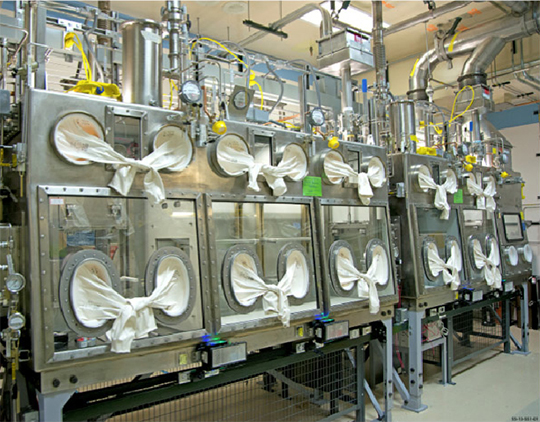
The National Nuclear Security Administration wants to expand its supplier base for the highly engineered glove boxes needed to speed up production of new plutonium pits for nuclear weapons.
The airtight, pressurized containers, are in high demand at NNSA facilities such as Los Alamos National Laboratory, which is gearing up to produce at least 30 softball-sized plutonium pits per year to provide the primary trigger for new warheads.
In hopes of buying more gloveboxes faster, NNSA has hired Los Alamos-based Merrick Strategic Management Solutions to design demonstration boxes that will be used to evaluate potential fabricators’ abilities to make new ones to lab specifications.
Under a sole-source contract announced Tuesday, Merrick will “provide the subject matter expertise to support fabricator capability development in accordance with design specifications, and review fabricators ability to meet the necessary design specifications.”
“The information gathered through this program will be provided to the NNSA Matrixed Execution Team (MET) Glove Box Working Group (GBWG), and the information will be utilized to expand glovebox procurement efforts and the number of capable glovebox fabricators to meet NNSA efforts to support pit production,” the notice said.
Merrick in 2018 was named a subcontractor to Triad National Security for the design, and engineering of capital construction and infrastructure improvements at Los Alamos under Triad’s ten-year management and operating contract, worth about $2.5 billion per year.
There are so few companies within the U.S. — all equipment used in PF4 must be manufactured in the United States with domestically sourced components — with the proper capabilities to machine gloveboxes to exacting NNSA standards that Los Alamos is practically the only customer, according to Robert Webster, Los Alamos’ deputy director for weapons.
“Our effort has basically saturated the market,” Webster said during the recent tour of the lab’s PF4 Plutonium Facility. A few other industries use gloveboxes as sophisticated as those at Los Alamos, namely the pharmaceutical and aerospace industries, Webster said. But NNSA is by far the most demanding customer, Webster said during a rare tour of the facility on June 22.
Lab employees approach the boxes and slide their hands into sealed rubber gloves of various thicknesses so they can safely handle the plutonium and other radioactive materials within the steel walls, peering through thick glass at their work. Once plutonium enters the facility it is held in sealed containers until it enters the self-contained, pressurized system of connected gloveboxes.
The lab rooms containing the boxes are also under negative pressure, but at a higher pressure than inside the boxes, to ensure that any potential radioactive contaminants flow away from personnel. The rooms, in turn, are at a lower pressure than the hallways between them.
Gloveboxes at the lab’s PF4 plutonium facility, most of which are Cold War vintage, are being replaced with modern versions to support that production ramp, but it is a time-consuming and tedious process, as the Exchange Monitor saw.
A single large glovebox being installed while Monitor was in the facility arrived at Los Alamos in pieces in October and was assembled on site, then moved into PF4, said Chris Pearson, senior director of integration for plutonium integration projects. The lab hopes to have that glovebox operational sometime in July, about nine months after installation began, Pearson said.
New gloveboxes are designed to be more robust than the ones they replace, with vibration-attenuating legs and more easily replaced gloves, among other improvements, Pearson said.
Swapping one glovebox for another takes time because the old boxes must be sealed from neighboring boxes. A protective tent is erected around the old glovebox while it is disassembled in place and then the new box is moved in and assembled, Pearson said.